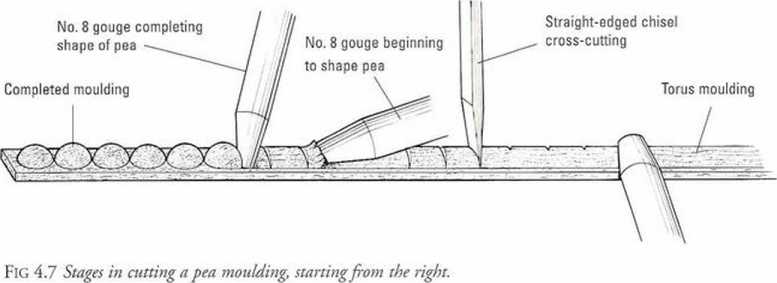essentÊrving°56

Essential Woodcarvixc Techniques
Critical factors in cutting mouldings are the sizes and sections of che wood selected and che sizes and swceps of the chisels available.
The examples shown herc arc students’ first attempts and therefore Iook experimental.
Pea or Shot Moulding
To carve a pea moulding you can use a prepared moulding. However, a useful hridging exercise from chip carving is to use an inverted No. 8 gouge with somc inside bevel, or an equivalent backbent, ro carve a ridge along the grain for a fcw inches. This ensures chat the detail of the moulding is as close as possible co the shape of the chisel. It helps if the width of che ridge is established first and the wood on each sidc is carvcd down to the right depth with a V tool or gouge before shaping the ridge. If the wood is not straight grained your gouge may wander from its course and splincer pieces from the side. Once you have your ridge, mark off the width of the gouge repeatedly along it. You will also nced a straight-edge (No. 1) as widc as or slightly wider chan the gouge (Fig 4.7).
The essencc of good moulding carving is to build up a rhythm. It is also a way of developing speed and defeness. You should praciise one or two units out of each moulding before beginning the run to make surÄ™ you know which tools to use and in which order. Once the tools have bccn selected, spread them on the bench in a fan with the blades rowards you and put all others away.
With the straight-edge a cut is madc across the grain at each gouge-width mark. If the wood is dense or brittle the effect of driving the wedge-shaped edge of the chisel in all the way will probably be to pop the pieces off. Practice is needed to learn how far you can go. Travel from one end of the run to che other. Then, with the invcrtcd No. 8 gouge, carve one side of each pea in the same sequence (Fig 4.7). As with the boss in Chapter 3, engage the edge with the wood just past the centre to avoid making the pea pointed. The chisel is pushed forward and the handle raised so that the tool finishes in a vertical position with the edge rescing in the cross siab cut. If the shaping of the pea is done without the first stab or cancelling cut there is a risk that the nexc pea will be split off. Having travelled in one dircction tum the chisel round and go in the oppositc dircction. Professional carvers usually become ambidextrous as this makes for speed.

— 56 __
Wyszukiwarka
Podobne podstrony:
img453 (7) Ali in a days work Speaking 1 Look at the picture. What are the advantages and disadvanta
image062 grew in places elevated over the surroundings and - except of the largest ones - were fence
essent?rving?14 pp Essential Woodcarvixg Techniques W Fig 1.17 Ttoo grounders. Very narrow old Engli
essent?rving?28 Essential Woodcarving Techniques Phloem or bast Bark Wood or xylem Roots anchor the
essent?rving?10 Essentiai. Woodcarying Techniques Makes of Tool Maker/brand Country Edge-
essent?rving?84 Essential Woodcarving Techniques Fig 7.7 This is how a piece of card would look if f
essent?rving?98 Essential Woodcarving Techniques Fig 9.1 Various lines. The one on the left Incks in
essent?rving?14 ESSENTIAL WOODCARNING TECHNIQUES 1 Base flattened before beginning carving. downward
essent?rving?52 Essential Woodcarying Techniques Fig 14.3 Mov mg water. Fig 14.4 Drawings devełoping
Isolation An essential ingredient of any safe system of work is the method and integrity of the isol
s&h 063 G3 STRi:’GTII A I> HEALTH chief factors in produeiug obesity. Kxercise buras up tlić exce
s&h 063 G3 STRi:’GTII A I> HEALTH chief factors in produeiug obesity. Kxercise buras up tlić exce
In addition, this legał or nalural person may request advice on the design and conduct of pharmacovi
Section 1: Describe the need and role of addressing in a network (5 Ä…uestions) 148
jff 014 that you work in a morÄ™ "easy", relaxed manner and will enjoy the give and take of
Family and rei VOCABULARY Work in pairs. Look at the pictures (1 -4) and discuss the guestions. f
Abstract The goal of the research is to analyse the role and significance of standardisation and cus
6 Contents Katarzyna Kita, Walenty Poczta, Anna Ziemińska: Changes in the level and structure of the
więcej podobnych podstron